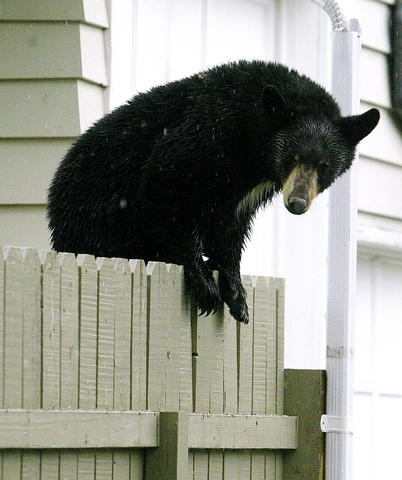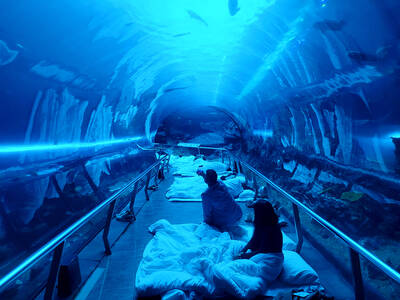In the communities around the Ocala National Forest, in Florida, bears overturn garbage cans, walk through porch screens, raid bird feeders and jump up and down on Dumpster lids to scrounge food - especially during the fall, as bears prepare to hibernate and their food intake doubles.
More than 1,100 complaints about bears have come into the Florida Fish and Wildlife Conservation Commission's (FWC) Ocala office so far this year. The source of the bear problem is often a matter of trash management. If one person in a neighborhood puts out garbage the night before a morning trash pickup in a bear-populated area, bears may continue to raid garbage cans.
When bears become too much of a nuisance, they're trapped, tagged and moved. If they break into a house or chase someone for food, they are captured and killed. This year, 11 aggressive bears have been captured and euthanized in the 12-county area that includes the Ocala National Forest, the largest of eight bear-populated areas in Florida.

PHOTO: AP
No hunting of bears has been allowed in Florida since 1994. The state's bear population is recovering from decades of hunting; according to estimates, there are now 2,500 to 3,000 bears in the state.
"We've been working so hard to get bears back. Now we have a good population of bears and a lot of people who have never been around bears before," said Mike Orlando, assistant coordinator of the FWC's bear management program. "It's hard to resist leaving out food. But once you get a bear going down that path, it usually leads to its demise."
It's illegal to put out trash, birdseed or other sources of food that attract bears and create a public nuisance. An exception is wildlife feeders in the woods.
Bill Persons enjoys spending time at a hunting lease called Seminole Woods. He sees bears often while hunting the land near the Wekiva River west of Sanford. Sometimes he sees them roaming, other times bears eat the corn dispensed by his game feeder, a mechanical device with a timer that hangs from a tree.
Last week, Persons invited me to Seminole Woods to see a bear that had been visiting his game feeder. I arrived on a Wednesday afternoon, changed into camouflage clothing and readied my camera. Persons took me to a tree blind positioned near his game feeder.
I was in luck. With the feeder in front of me and the wind in my face, the bear was not likely to detect my scent. Perched 3m above the ground in the tree stand, I waited, listening to falling acorns, the hooting of barred owls and the distant rumbling of motorcycles.
Then, at 6:05pm, a lump of black fur walked softly into the clearing below Persons' game feeder. The bear seemed totally relaxed. I wasn't. Thrilled to see a bear in the wild and realizing the light available for photos was dwindling, I raised my camera and started clicking.
The bear noticed me, sensed something was wrong, stood up on its hind legs, spun around and scampered off into the thicket. I managed to shoot three photos.
Some 30 seconds after my camera spooked the bear, the game feeder started slinging corn. The bear's timing was impeccable. It knew when to arrive for a snack.
I climbed from the tree stand and waited for the bear to return. It did, but by then it was too dark for photos. I could hear the bear crunching corn. When I walked toward the clearing with my camera, the bear vanished.
About 10 years ago, Persons photographed a bear as it climbed a sloped palm tree toward his hunting blind. Hidden in the blind, Person was about 3m from the bear when he started shooting photos. Hearing the sound of the camera shutter, the bear put its paws together, walked down the palm tree and disappeared.
The bears Persons encounters at Seminole Woods are wild. They fear humans. If they notice something irregular, they're gone - except in rare cases in which someone comes between a female bear and her cub, as Persons did once by mistake.
What wildlife officials struggle with is human-bear encounters around neighborhoods, businesses and campgrounds, where bears often return again and again in search of easy meals.
In the town of Astor on the east side of the Ocala National Forest, an electric fence has been placed around the Dumpster behind Sterling's Family Restaurant to keep bears away. This summer marked the first time in 20 years the restaurant has had a bear problem.
At the Astor Family Market, a bear continues to raid the Dumpster every night, leaving a trail of rubbish leading into the woods behind the store. Managers secure the Dumpster lid with a chain and padlock, but the bear finds a way in. Assistant manager Theresa Reaves said the store is on a waiting list for a bear-proof Dumpster.
At the Alexander Springs campground this summer, a bear noticed a man pulling a cooler from the back seat of his truck and approached him. The man dropped the cooler and reported the incident. Considered too aggressive, the bear was captured and killed.
"Once a bear learns an ice chest contains food, that search image is embedded in its head," said Carrie Sekerak, a biologist with the US Forest Service. "A bear is probably as smart as a human toddler. They're smarter than the smartest dog you've ever owned."
"Black bears are not dangerous at all," Dick said. "It's the people who are dangerous to the bears. The best way to see a bear is its rear end running away from you."
Florida black bears
>> Species: The Florida black bear, ursus americanas floridanus, is one of three subspecies of the American black bear. It has a highly arched forehead and a long, narrow brain case.
>> Status: Listed as threatened by Florida except in Baker and Columbia counties and in the Apalachicola National Forest.
>> Size: Adult males reach 110kg to 250kg. Females reach 50kg to 110kg. The largest Florida black bears on record are 280kg (male) and 170kg (female).
>> Lifespan: The oldest Florida bear was 18 when it died.
>> Cubs: Florida bears typically give birth to two or three cubs every other year, usually in February. The cubs stay with the mother for about 18 months. Nearly 25 percent of cubs die before they reach two years of age from starvation, predation by other bears or collisions with cars.
>> Danger to humans: There has never been a documented human attack by a Florida black bear. They are generally shy. Those that become too aggressive in seeking food may be moved or euthanized.
>> If you encounter a bear: It should run away if it sees you. Bears dependent on human food sources or females protecting their cubs can become threatening. If confronted, avoid direct eye contact, speak calmly, stand upright and back away slowly. Make sure the bear has an escape route. Do not run.

Beijing’s ironic, abusive tantrums aimed at Japan since Japanese Prime Minister Sanae Takaichi publicly stated that a Taiwan contingency would be an existential crisis for Japan, have revealed for all the world to see that the People’s Republic of China (PRC) lusts after Okinawa. We all owe Takaichi a debt of thanks for getting the PRC to make that public. The PRC and its netizens, taking their cue from the Chinese Communist Party (CCP), are presenting Okinawa by mirroring the claims about Taiwan. Official PRC propaganda organs began to wax lyrical about Okinawa’s “unsettled status” beginning last month. A Global

We lay transfixed under our blankets as the silhouettes of manta rays temporarily eclipsed the moon above us, and flickers of shadow at our feet revealed smaller fish darting in and out of the shelter of the sunken ship. Unwilling to close our eyes against this magnificent spectacle, we continued to watch, oohing and aahing, until the darkness and the exhaustion of the day’s events finally caught up with us and we fell into a deep slumber. Falling asleep under 1.5 million gallons of seawater in relative comfort was undoubtedly the highlight of the weekend, but the rest of the tour

Music played in a wedding hall in western Japan as Yurina Noguchi, wearing a white gown and tiara, dabbed away tears, taking in the words of her husband-to-be: an AI-generated persona gazing out from a smartphone screen. “At first, Klaus was just someone to talk with, but we gradually became closer,” said the 32-year-old call center operator, referring to the artificial intelligence persona. “I started to have feelings for Klaus. We started dating and after a while he proposed to me. I accepted, and now we’re a couple.” Many in Japan, the birthplace of anime, have shown extreme devotion to fictional characters and

Youngdoung Tenzin is living history of modern Tibet. The Chinese government on Dec. 22 last year sanctioned him along with 19 other Canadians who were associated with the Canada Tibet Committee and the Uighur Rights Advocacy Project. A former political chair of the Canadian Tibetan Association of Ontario and community outreach manager for the Canada Tibet Committee, he is now a lecturer and researcher in Environmental Chemistry at the University of Toronto. “I was born into a nomadic Tibetan family in Tibet,” he says. “I came to India in 1999, when I was 11. I even met [His Holiness] the 14th the Dalai